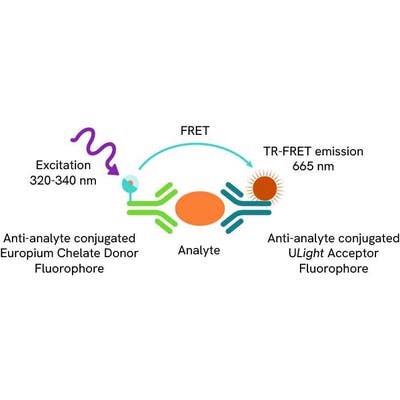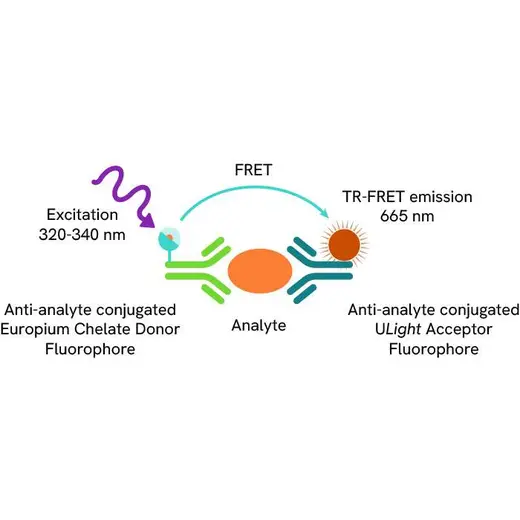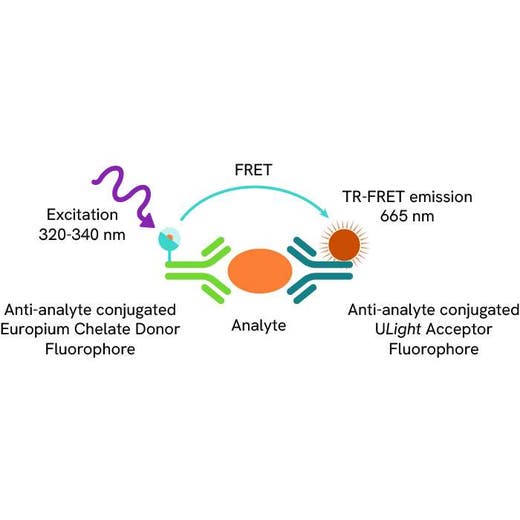
LANCE Ultra Human Fibronectin Detection Kit, 500 Assay Points

LANCE Ultra Human Fibronectin Detection Kit, 500 Assay Points




The LANCE® Ultra Human Fibronectin Detection Kit is designed for detection and quantitation of human fibronectin in buffered solution and cell culture media using a homogeneous TR-FRET (no-wash steps, no separation steps) assay.
For research use only. Not for use in diagnostic procedures. All products to be used in accordance with applicable laws and regulations including without limitation, consumption and disposal requirements under European REACH regulations (EC 1907/2006).
| Feature | Specification |
|---|---|
| Application | Protein Quantification |
| Dynamic Range | 70 - 300,000 pg/mL |
| Limit of Detection | 70 pg/mL |
| Limit of Quantification | 380 pg/mL |
| Sample Volume | 15 µL |
The LANCE® Ultra Human Fibronectin Detection Kit is designed for detection and quantitation of human fibronectin in buffered solution and cell culture media using a homogeneous TR-FRET (no-wash steps, no separation steps) assay.
For research use only. Not for use in diagnostic procedures. All products to be used in accordance with applicable laws and regulations including without limitation, consumption and disposal requirements under European REACH regulations (EC 1907/2006).


LANCE Ultra Human Fibronectin Detection Kit, 500 Assay Points


LANCE Ultra Human Fibronectin Detection Kit, 500 Assay Points


Product information
Overview
The LANCE® Ultra Human Fibronectin Detection Kit is designed for detection and quantitation of human fibronectin in buffered solution and cell culture media using a homogeneous TR-FRET (no-wash steps, no separation steps) assay.
- No-wash steps, no separation steps
- TR-FRET technology
- Sensitive detection
- High reproducibility
- Faster time-to-results
- Easy automation
- 96-well, 384-well, and 1536-well formats
LANCE® and LANCE® (Lanthanide chelate excite) Ultra are our TR-FRET (time-resolved fluorescence resonance energy transfer), homogeneous (no wash) technologies. One antibody of interest is labeled with a donor fluorophore (a LANCE Europium chelate) and the second molecule is labeled with an acceptor fluorophore (ULight™ dye). Upon excitation at 320 or 340 nm, energy can be transferred from the donor Europium chelate to the acceptor fluorophore if sufficiently close for FRET (~10 nm). This results in the emission of light at 665 nm.
Fibronectin is a large glycoprotein of the extracellular matrix that exists in two forms: insoluble (cellular) and as a soluble plasma protein. The primary functions of fibronectin are its involvement in cell adhesion, growth, migration, and differentiation. Fibronectin is known to contribute to the wound healing process where it will accumulate at the site of injury to help form blood clots and aid in the development of new tissues. Fibronectin levels in plasma have been identified to increase significantly after major traumas. Further, Fibronectin levels have been observed to be significantly altered in disease states of certain types of cancer and also diabetes mellitus.
Specifications
| Application |
Protein Quantification
|
|---|---|
| Automation Compatible |
Yes
|
| Brand |
LANCE Ultra
|
| Detection Modality |
LANCE
|
| Dynamic Range |
70 - 300,000 pg/mL
|
| Limit of Detection |
70 pg/mL
|
| Limit of Quantification |
380 pg/mL
|
| Product Group |
Kit
|
| Sample Volume |
15 µL
|
| Shipping Conditions |
Shipped in Blue Ice
|
| Target |
Fibronectin
|
| Target Class |
Biomarkers
|
| Target Species |
Human
|
| Technology |
TR-FRET
|
| Therapeutic Area |
Oncology
|
| Unit Size |
500 Assay Points
|
Resources
Are you looking for resources, click on the resource type to explore further.
LANCE™ Ultra TR-FRET is a no-wash proximity assay technology that combines the benefits of time resolution (TR) with fluorescence...


How can we help you?
We are here to answer your questions.






























